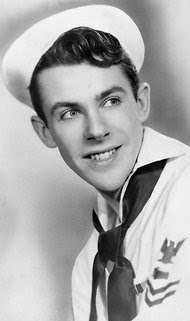Meeting Phyllis and Adolph altered my perspective, because suddenly, it wasn’t enough any more to strive to be the sort of person whom Gene Kelly might play in a movie. No, from that moment on, I wanted to be Adolph Green.
I still do. A paragon of easy sophistication, an accomplished, even magical writer, a sly charmer, and — not least — a man whose record collection filled an entire room of the Greens’ apartment, with shelves that lined every wall from floor to ceiling. When you’re Leonard Bernstein’s former roommate and sometime collaborator, as Adolph was, it’s only natural that you learn a few things about music — but clearly Adolph was prodigious in his own right.
Nobody who comes to New York does so without expectations, and like mine, our expectations of the city evolve over time. That’s true as well for the character Gene Kelly plays in the “Broadway Melody” ballet, and it was probably true for another immigrant from the American Heartland, Cris Alexander, an actor and photographer who passed away this month at the age of 92.
Alexander came to New York from Oklahoma; his first job on Broadway was as one of three sailors on leave in a little show called On the Town. He played Chip, the sailor of the three with the most fixed and precise expectations of New York City — all of which are derived from an out-of-date guidebook and easily dispatched by the brash taxi driver who advises him to forget sightseeing and “Come Up to My Place.”
Among Alexander’s co-stars were Betty Comden and Adolph Green, who, not content with writing the show, had created roles for themselves to play, as well, and that sort of chutzpah is very much a part of the mystique of the city for me. You get together with a few talented friends (such as the show’s composer, the aforementioned roommate Mr. Bernstein), you have a great time, and somehow the result is a terrific show.
Comden and Green had done something similar already with their nightclub act, called the Revuers, which also embraced Judy Holliday; later in their careers, Comden and Green recorded several Revuers numbers, which remain as fresh and funny today as when they wrote them.
The other credit for which Cris Alexander is best known is Little Me, a spoof of Hollywood autobiographies by Patrick Dennis, for which Alexander — a successful professional photographer — provided the pictures, combining stock images with original, artfully staged creations. What we see is a bunch of friends putting on silly costumes and horsing around. But considering who the friends were, we’re also seeing something quite special.
Among the friends, for example, are Dennis himself; his Auntie Mame of stage and screen, Rosalind Russell (also star of Bernstein and Comden and Green’s Wonderful Town, which co-starred Cris Alexander); Alice Pearce, the original Lucy Shmeeler of On the Town on stage and screen (as well as the original Gladys Kravitz); and Shaun O’Brien, a dancer with New York City Ballet.
Most of these folks wound up creating more lasting and significant art in other places and other ways. Little Me itself went on to be a Broadway musical, with a book by Neil Simon, though not a terribly successful one. But what fun these people had! You look at the pictures and envy them — and the New York they used to call their home.
There are days when I don’t feel like Gene Kelly, when I feel as if the ongoing party that is New York City came to an end just as I arrived here. Comden and Green used to perform at parties, and A Party was the name they gave to their duo act when they took it to Broadway in the 1970s. But all I’ve got is the cast album.
It’s harder these days to put on any kind of a show, harder just to get a group of friends together — no matter how talented they may be. (Amanda Green, for example, is constantly on the go. Just try to keep up with her.) In a city that is more and more focused on money and less on art, certain kinds of possibility are dwindling, or gone already.
 What a party!
What a party!Alexander used to host and photograph dress-up parties, which in turn inspired Patrick Dennis to write Little Me and a second book, a spoof of White House memoirs, First Lady: My Thirty Days Upstairs at the White House, by Martha Dinwiddie Butterfield.
(My own copy of that book has gone missing.)
And yet other possibilities are just beginning. Shaun O’Brien and Cris Alexander were partners for more than six decades, and last year, they married in New York State. They died just two weeks apart, in Saratoga Springs, City Ballet’s second home, where they made their retirement. O’Brien went first; a friend told the New York Times that Alexander had died of a broken heart.
Maybe they didn’t need any official imprimatur to certify their relationship, but it was only last year that they could marry legally — and they did. What a happy final chapter to what was, as Alexander put it, “a lovely life.”
Read more!



























































